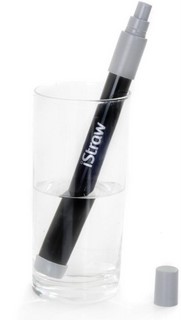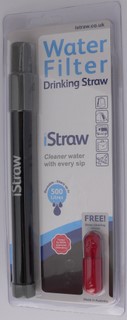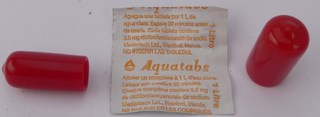
One of the greatest needs for any human being is access to good drinking water. Without clean water a host of waterborne diseases can quickly ruin one’s day if not one’s life.
Here’s an Australian solution which addresses the problem of contaminated water, particularly for travellers. This Water Filter Drinking Straw is like taking some 1300 bottles of clean drinking water with you on your journeys.
Without the weight and the cost of them.
And there’s another, huge, side benefit to the iStraw as well. Here’s how it works.
As with all inventions, simplicity is key to success. The iStraw is built around the most basic of human reflexes: the sucking motion. The first thing a new-born baby does with purpose is to suck. And in old age, when most other parts of the human body have ceased to function properly, drinking through a straw is probably the only way to get some nutrition.
So the iStraw is basically one big straw with in-built filtration. How big is it? It’s the same length (20cm) as a normal straw but a lot thicker(17mm), like one of these big marker pens. It has a protective cap to cover the mouthpiece.
The comparatively small size and light weight (just 22g) makes it ideal for backpackers and business travellers alike. The iStraw’s filter is good for some 500 litres of clean water without the aftertaste that you have with water purification tablets.

How Clean is This Drinking Water?
The iStraw protects against waterborne bacteria and protozoa that are present in the drinking water of many countries. It reduces up to 99.99999% of all these bacteria, including Giardia and Cryptosporidium. It filters down to 0.1 micron and both the iStraw itself and its micro-filtration process has been tested and approved by a NATA approved laboratory.
Does it mean you can use the iStraw for all kinds of situations?
Let’s look at some of the Operating Instructions first.
If operating and maintenance instructions are observed, the iStraw can be expected to filter up to 500 litres of municipal or town tap water.
The ultimate capacity of the iStraw depends on the quality of water to be filtered. Also: the iStraw must not be used to filter brackish or turbid water or to filter hot water – hot in this case means water having a temperature over 32oC or 90oF.
The iStraw must also not be frozen otherwise damage to its special filter membrane will occur.
Our house, being in rural Australia, depends on rainwater for all our drinking, cooking and bathing needs. We have a couple of big tanks with only a basic filter to strain the baddies. These tanks are covered but you don’t want to know what makes its way into the tanks from the gutters…
So even though the taste of our drinking water is great and much better than town water, the iStraw would make an unseen and untasted difference in this situation.
You just felt more comfortable drinking the extra filtered water.
We also have a creek running through our property. It’s fed by springs in the hills so the quality should be OK even though the water is slightly coloured brown because of the tannin. I had never tasted it before but this was a good opportunity to try it out.
Another source of water on our property is a large dam. We use it for irrigation as the soak is fairly muddy and tannin-coloured as well. I would have tried it out but for one fact: the other day a large kangaroo drowned in that dam and that has put me off… I don’t think you’ll blame me from chickening out on that test…
So How Does It Work?
Darren Khan, who is joint owner of the iStraw with his partner Jason Cox, explains:
"iStraw membranes are hollow strands of porous fibres that prevent the passage of certain contaminants in water while permitting water molecules to flow through its wall to inside of each strand. The surface of each membrane fibre consists of millions of microscopic pores that block the passage of all particles larger than the size of its pores, creating a physical barrier to contaminants making this selective filtration possible. Water is drawn through the pores with the use of a slight suction, much like that required when sipping water through an ordinary straw."
Jason and Darren specialise in bringing innovative products to market. They were approached by the Australian company who had developed a personal water filter concept and, using their combined experience and expertise, iStraw emerged.
The idea for the iStraw came about from the question: "What if you could just use a straw to filter contaminated water?"
So the idea for a water filter drinking straw sounded simple enough and work on the iStraw began back in Australia. They went to work on the various combinations of microfiltration membranes into a straw. Even though the idea was simple it took 3 years to develop and hundreds of combinations…
Our Findings
It takes a fair bit of sucking to draw up the water and the flow is not as strong as with a clear straw. Physics alone could have told you that. It’s no problem though. When you’re done drinking there’s still a fair bit of water in the tube. Now when you’re travelling and you pack the iStraw away I would advise strongly to shake out the excess water and to put the iStraw in a sealed plastic bag. In fact, I would advise the folks at iStraw to come up with a cap for the bottom opening. It’s as simple as that. There is already a mouthpiece cover that serves the same protective purpose.
Note: The iStraw does not remove chemical contaminants or viruses contained in water. If there is a risk of contamination, chemical disinfecting products must first be used to neutralise the contamination. Chlorine-based drinking water disinfectants, purification tablets, can be used for this purpose. It would have been handy to also have included some of these tablets for emergencies with stagnant water that you might find in a ditch, pool or creek. Seawater or sugary substances in water are definitely out of the question.
There is a big red capsule that comes with the iStraw containing a couple of Aquatabs. These are used for regularly cleaning the iStraw.

Another Planet-Saving Benefit
The iStraw, as a personal water microfiltration system, ensures safe drinking water at the source without the need to carry water or use heavy filtration equipment. More importantly, iStraw reduces the need to purchase bottled water with its resultant packaging and transportation pollution and reduces the need for chemical disinfection. Think about the billions of bottles that are being discarded in landfills or tossed in our waterways because of our need for clean drinking water and what products like the iStraw and the "Life Saver" bottle can mean for our thirsty planet. Fortunately, these products are not only simpler to use but also very cost effective compared to bottled water, purification tablets and other expensive filtration equipment. Imagine: 1 iStraw alone reduces the pollution and cost of up to 1330 discarded plastic bottles!
Conclusion
Priced at just under 20 pounds sterling or 40 bucks US this is a very reasonable investment to replace over a 1000 plastic bottles of water. Of course, you still have to find a decent source of not too dirty water on your travels but how hard can that be? As for me, I’ll always carry one in my flightbag from now on. I normally carry a fair few bottles of drinking water in our 6-seater aircraft as we fly often over the great Australian Outback. Just in case we have an “unscheduled” landing somewhere… Any savings in weight by leaving out a few extra “just in case” bottles means I can take on more fuel and fly farther.
A great Aussie invention and highly recommended!


